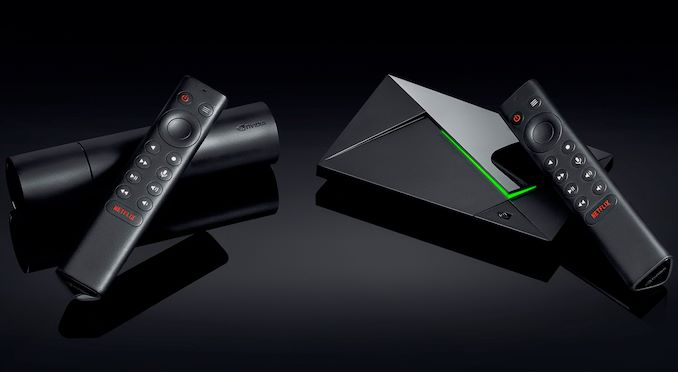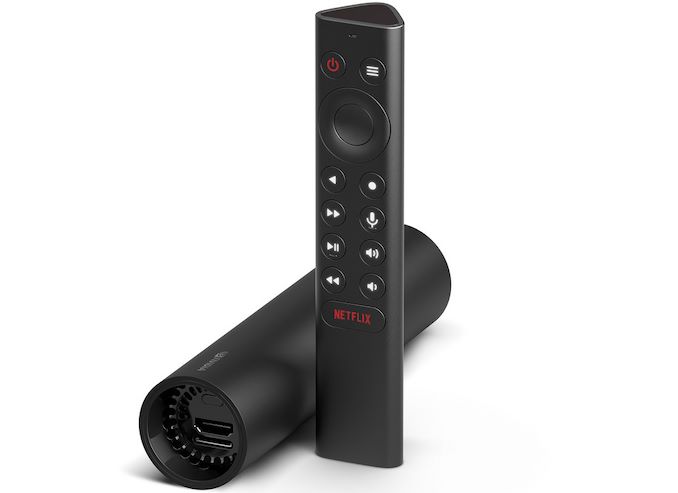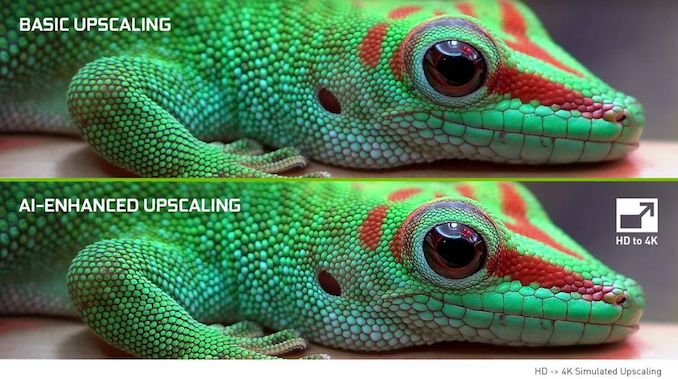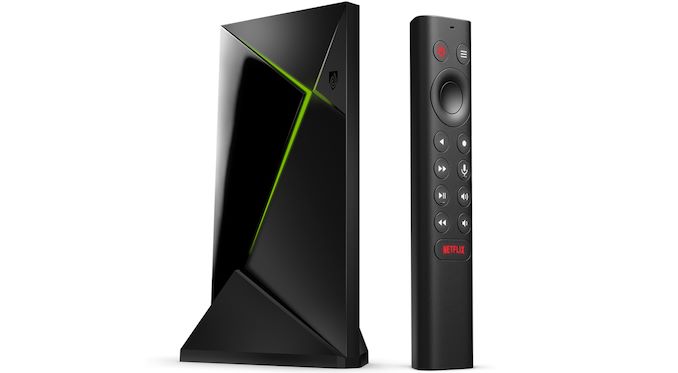NVIDIA Reveals New SHIELD TV: Tegra X1+, Dolby Vision, Dolby Atmos
by Anton Shilov on October 29, 2019 11:00 AM EST
NVIDIA has introduced new versions of its SHIELD TV set-top-boxes featuring an all-new design as well as based on an improved Tegra X1+ SoC. The new STBs support all the features its predecessors do and add support for Dolby Vision HDR, Dolby Atmos audio, as well as a new AI-powered upscale algorithm. With the launch of the new devices NVIDIA somewhat changes concept of its STBs as they no longer come with a gamepad.
The new NVIDIA SHIELD TV devices use the company’s new Tegra X1+ SoC that is said to be 25% faster when compared to the original one launched over four years ago. The chip essentially has the same feature set and Maxwell graphics, so games developed with the original SoC in mind will work with the new one without any problems. Meanwhile, since the Tegra X1+ is made using a more advanced process technology, this allows NVIDIA to offer the new SHIELD TV in a more compact form-factor. At the same time, the new SoC is paired with 2 GB of RAM (down from 3 GB) as well as 8 GB of NAND flash storage (down from 16 GB previously), which can be expanded using a microSD card. The SHIELD Pro has 3 GB of RAM as well as 16 GB of NAND storage, but no longer has a hard drive.
NVIDIA made its new SHIELD TV smaller than the predecessor in a bid to better compete against compact streaming media device, such as Google’s Chromecast/Chromecast Ultra. From connectivity standpoint, the new STB features Wi-Fi 5, Bluetooth 5.0, a GbE port, an HDMI 2.0b output with HDCP 2.2, and a microSD card slot. Meanwhile, it no longer has USB 3.0 ports, possibly to save space and simplify design. Those who need USB 3.0 should buy the SHIELD Pro with two USB Type-A ports.
| NVIDIA SHIELD STB Family | ||||||
| SHIELD TV (2019) |
SHIELD TV Pro (2019) |
SHIELD TV (2017) |
SHIELD TV Pro (2017) |
SHIELD Android TV (2015) |
||
| SoC | Tegra X1+ | Tegra X1 (4 × Cortex A57 + 4 × Cortex A53, Maxwell 2 SMM GPU) |
||||
| RAM | 2 GB | 3 GB | 3 GB LPDDR4-3200 | |||
| Storage | 8 GB NAND microSD |
16 GB NAND USB |
16 GB NAND USB |
16 GB NAND 500 GB HDD microSD USB |
16 GB NAND 500 GB HDD (Pro only) microSD USB |
|
| Display Connectivity | HDMI 2.0b with HDCP 2.2 (4Kp60, HDR) | |||||
| Dimensions | Height | 40 mm 1.57 inch |
98 mm 3.858 inch |
130 mm 5.1 inch |
||
| Width | 40mm 1.57 inch |
159 mm 6.26 inch |
210 mm 8.3 inch |
|||
| Depth | 165 mm 6.5 inch |
26 mm 1.02 inch |
25 mm 1 inch |
|||
| Weight | 137 grams | 250 grams | 654 grams | |||
| Power Adapter | integrated | ? | 40 W | |||
| I/O | Wireless | 2x2 802.11a/b/g/n/ac Bluetooth 4.1/BLE |
||||
| USB | - | 2 × USB 3.0 | 2 × USB 3.0 1 × micro-USB 2.0 |
|||
| IR | - | - | - | IR Receiver | ||
| Ethernet | Gigabit Ethernet | |||||
| Launch Product Bundle | Shield Remote | Shield Controller Shield Remote |
Shield Controller | |||
| Launch Price | $149.99 | $199.99 | $199.99 | $299.99 | Basic: $199.99 Pro: $299.99 |
|
When it comes to decoding capabilities, the new SHIELD TV can decode H.265/HEVC, VP8, VP9, H.264, MPEG1/2, H.263, MJPEG, MPEG4, and WMV9/VC1 video. Meanwhile, the STB does not support AV1 as well as VP9.2 codecs because they are not widespread at the moment. The new SHIELD TV can playback 4Kp60 HDR, 4Kp60, Full-HD 60 fps content, and can upscale 720p and 1080p content to 4Kp30 using an AI-enhanced algorithm. It is unclear whether the algorithm relies on a new hardware block that is present only inside NVIDIA’s Tegra X1+, or uses a combination of hardware and software, which means that it could be enabled on previous-generation SHIELD TV consoles too
| NVIDIA's 2019 SHIELD TV STBs | |||
| Video | |||
| 4K HDR at 60 FPS | H.265/HEVC | ||
| 4K at 60 FPS | VP8, VP9, H.264, MPEG1/2 | ||
| 1080p at 60 FPS | H.263, MJPEG, MPEG4, WMV9/VC1 | ||
| HDR | HDR10, Dolby Vision | ||
| Containers | Xvid/ DivX/ASF/AVI/MKV/MOV/M2TS/MPEG-TS/MP4/WEB-M | ||
| Audio | |||
| Audio Support | AAC, AAC+, eAAC+, MP3, WAVE, AMR, OGG Vorbis, FLAC, PCM, WMA, WMA-Pro, WMA-Lossless, Dolby Digital Plus, Dolby Atmos, Dolby TrueHD (pass-through), DTS-X (pass-through), and DTS-HD (pass-through) | ||
| High-Resolution Audio Playback | up to 24-bit/192 kHz over HDMI and USB | ||
| High-Resolution Audio Upsample | up to 24-bit/192 kHz over USB | ||
The new SHIELD TV STBs come with a redesigned SHIELD remote with improved ergonomics and more buttons. The unit has a built-in microphone for Google Assistant and Amazon Alexa; motion-activated backlit buttons; Bluetooth connectivity to connect to the player; and an IR blaster to control volume and power on TVs, soundbars or receivers.
Being based on Android TV/Android 9.0 (Pie) platform, the SHIELD TV ships with a variety of content deliver apps, including Netflix, YouTube, Amazon Prime Video, Amazon Music, Vudu, Google Play Movies & TV, Plex, Google Play Games, NVIDIA Games, and Google Games. End-users may install additional apps themselves if they need to.
Because of the simplified design and the lack of bundled gamepad, the new NVIDIA SHIELD TV media players are cheaper than their predecessors: the base model costs $149.99 (down from $199.99), whereas the Pro model is priced at $199.99 (down from $299.00).
Related Reading:
- SHIELD TV Now Supports 120 Hz Refresh, Ups Wi-Fi Bandwidth for GeForce NOW
- NVIDIA Unifies GeForce NOW Service Across PCs and SHIELD TV STBs: 200+ Games Supported
- NVIDIA Temporarily Slashes $30 Off the SHIELD TV: Now Staring at $149
- NVIDIA Releases Android 7.0 Update for 2015 SHIELD TV, Adds Amazon Video App
- NVIDIA Launches SHIELD TV: Smart Home Functionality, More 4K HDR Streaming Services
- NVIDIA SHIELD Android TV Console Adds Support for Vudu, HDR and 4Kp60 Content
Source: NVIDIA













80 Comments
View All Comments
eastcoast_pete - Tuesday, October 29, 2019 - link
NVIDIA, you're lazy bums! What, only a die shrink, and not even an attempt at a more recent BIG ARM core? Not even trying anymore!MadDuffy - Tuesday, October 29, 2019 - link
Correction: SHIELD TV Pro (2019) now lacks micro sd card slot.wrkingclass_hero - Tuesday, October 29, 2019 - link
Amazing how virtually no progress has been made in the last 4 years. Several steps back too.Alistair - Tuesday, October 29, 2019 - link
Party like it is 2014, Note 4 style, with the nVidia Shield 2019.Beaver M. - Wednesday, October 30, 2019 - link
What do you want?8K120 support? A CPU that can emulate a i9-9900K PC? A GPU as fast as a 2080 Ti?
Please... this is still the best streaming multimedia player you can get. And even for enthusiasts it offers pretty much everything.
BenSkywalker - Wednesday, October 30, 2019 - link
I miss the IR functionality, I still have a launch Shield I use hooked up to my main AV setup and my Harmony Ultimate works with it, but won't with newer versions(17 or 19). Yes, that does matter considering my remote control costs more then a new Shield Pro.Yes I can use the Shield remote or controller, my phone or Google Home but I like one remote for everything.
Yojimbo - Wednesday, October 30, 2019 - link
It's cheaper and much smaller. It also has a much more mature platform than the raw device that one was paying for 4 years ago. The target market of the offering has shifted as NVIDIA has learned who the market is. It now comes with a remote instead of a controller, and the remote is supposedly improved over the original remote one had to pay extra for in 2015. They were probably hoping to add value with game sales in some way or another at the time of their 2015 launch. The only thing that matters as far as the price is how does the current device compare to the current competition at its current price point.Alistair - Wednesday, October 30, 2019 - link
I really can't stand the hyping. Here's the first video with benchmarks. 2-15 percent faster, never 25 percent (memory bandwidth is too limited unlike with the Tegra X2?)2 percent faster for gfxbench Manhattan. 3 percent for T-rex. Enjoy the video:
https://youtu.be/AYN4LUwXMxw?t=410
Beaver M. - Wednesday, October 30, 2019 - link
But why does it really have to be faster anyway?The old one was fast enough already to display 4K60 HDR content without hiccups.
We all know that a manufacturers claim about performance is always overdone. They always just select one single thing where they can achieve the biggest numbers.
I am just happy that I can actually get the best multi media streaming player for $150 now instead of 200, because I need 2 of them.
name99 - Wednesday, October 30, 2019 - link
The "faster" question has to do with whether there is a viable gamer community around this (and whether such a community can form around the Apple TV).Sure, if your only use case is displaying content, and that content is decoded in real time by the box, that's fast enough! That's certainly my situation.
Of course there's a slippery slope of additional functionality...
Most obvious is if you want to add Picture in Picture and now need two decoders (or the decoder to be twice as fast; or you have to provide a horrible user experience where some pairs of streams can support PiP, but not others.
But then you can start adding things like supporting multi-person Video Chat (think family chat with multiple separated family members on Christmas Day or Thanksgiving day), and now we need even more stream decoders...
(Nobody, as far as I know, really supports something like the above yet. You can fake it with Apple using AirPlay, likewise I assume on Android, but you still have to use the phone camera.
The next step in usability is camera support on these media console devices, but that's a tricky issue of where you place the camera... I think it's coming, likely with a separate wireless camera, but we'll see.
And once you have a camera, you make available a whole lot of "body motion" games likes Wii and DDR. But you now need a kick-ass image processing engine and NPU to extract that body motion from the video stream. And then you want to do that for two bodies...
And that doesn't just have to be for games. One could imagine this sort of thing being part of workout apps [make sure you do the movements correctly] or health apps [keep old people moving, physical therapy].)
And so it goes.